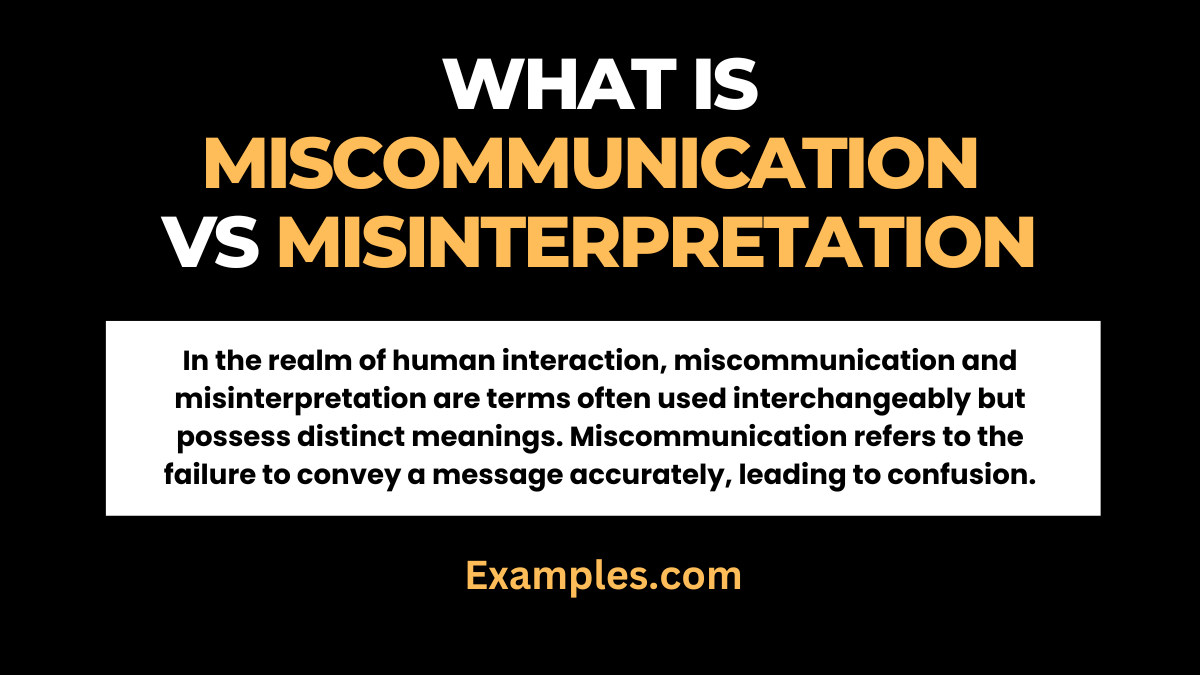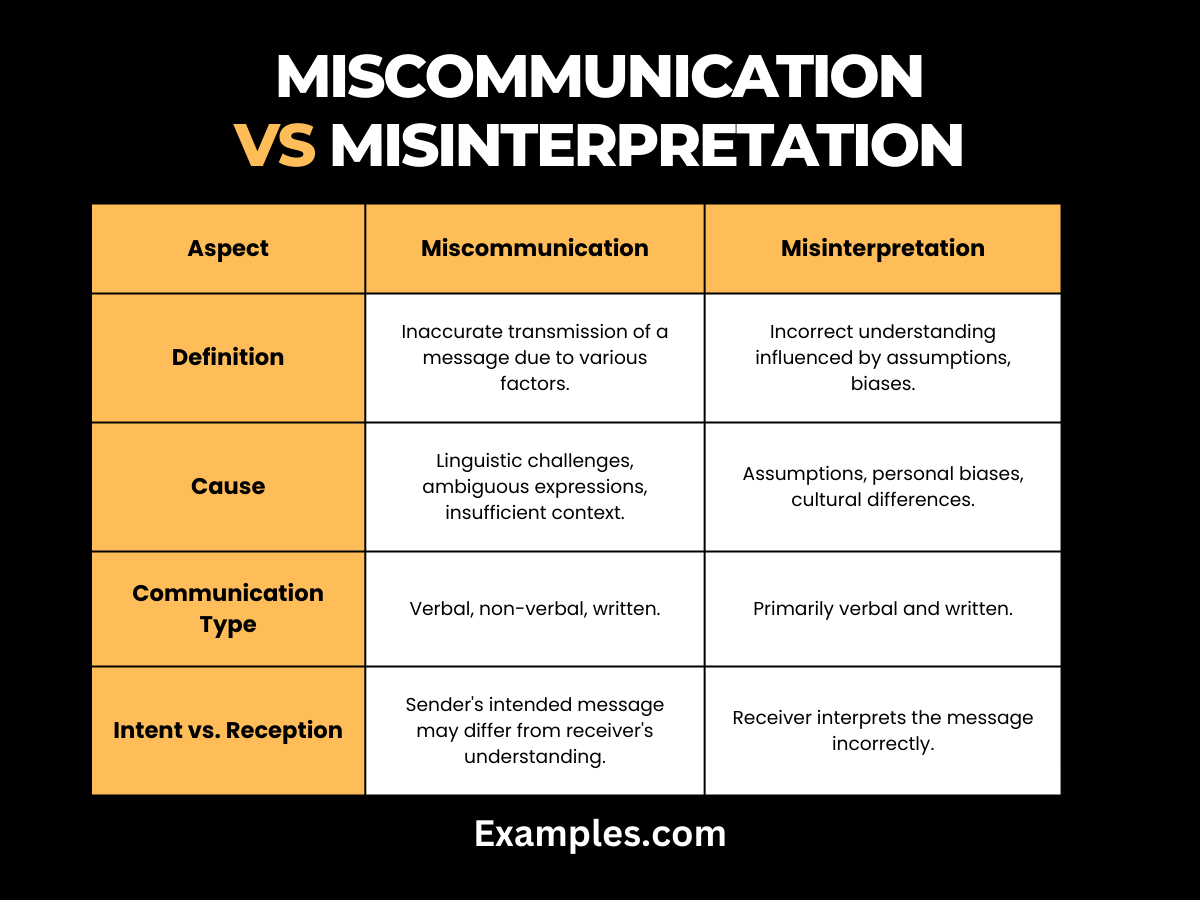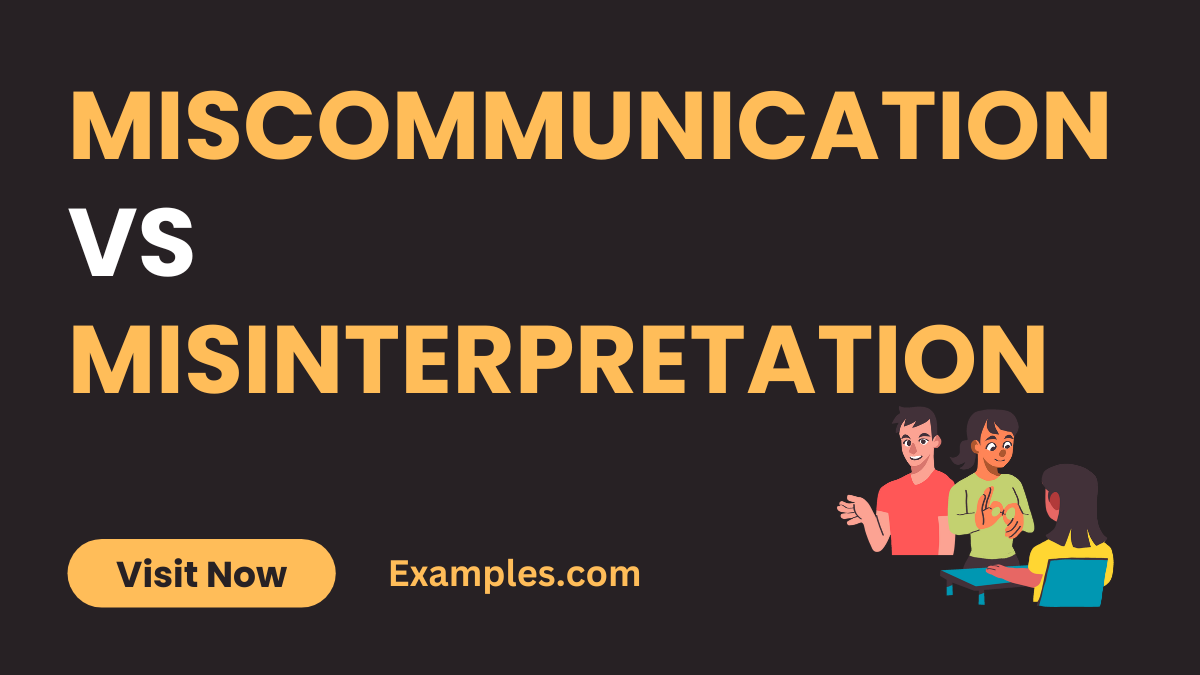Miscommunication vs Misinterpretation – 19+ Examples
In the intricate web of human interaction, understanding the disparity between miscommunication and misinterpretation is paramount. This comprehensive guide delves into the core distinctions, offering illuminating communication examples to demystify the intricacies. Uncover the subtle nuances that differentiate these two concepts, empowering you with insights and strategies to foster effective communication. Navigate real-world scenarios and enrich your communication toolkit through this insightful exploration of miscommunication versus misinterpretation. Communication examples abound, providing practical wisdom for enhancing interpersonal connections.
What is Miscommunication vs Misinterpretation

In the realm of human interaction, miscommunication and misinterpretation are terms often used interchangeably but possess distinct meanings. Miscommunication refers to the failure to convey a message accurately, leading to confusion. On the other hand, misinterpretation involves the receiver misunderstanding the intended meaning of a message. This H2 guide elucidates these concepts in clear, simple English, offering a foundational understanding of the subtle yet crucial differences between miscommunication and misinterpretation.
Difference Between Miscommunication And Misinterpretation
This detailed breakdown offers insights into the distinct characteristics of miscommunication and misinterpretation, highlighting their respective causes, communication types, impacts, and prevention strategies.

| Aspect | Miscommunication | Misinterpretation |
|---|---|---|
| Definition | Inaccurate transmission of a message due to various factors, such as language barriers or unclear expression. | Incorrect understanding of the message, often influenced by assumptions, personal biases, or cultural gaps. |
| Cause | Miscommunication can stem from linguistic challenges, ambiguous expressions, or insufficient context in the message. | Misinterpretation is driven by assumptions, preconceived notions, personal biases, and cultural differences that affect the receiver’s comprehension. |
| Communication Type | Encompasses verbal, non-verbal, and written forms of communication. | Primarily involves verbal and written communication channels. |
| Intent vs. Reception | The sender’s intended message may differ from how the receiver understands it, leading to discrepancies. | The receiver interprets the message incorrectly, deviating from the sender’s intended meaning. |
| Impact | Miscommunication can result in confusion, misunderstandings, and conflicts between the parties involved. | Misinterpretation often leads to misperceptions and distorted conclusions, impacting relationships and decision-making. |
| Examples | Examples include receiving ambiguous instructions, misunderstanding tone, or misinterpreting the intended meaning of a message. | Examples encompass instances of reading between the lines, misconstruing meanings, or inferring incorrect information from a message. |
| Prevention Strategies | Effective prevention involves employing clear communication methods, active listening, and ensuring the message is easily understandable. | Strategies include seeking clarification, confirming understanding through feedback, and being aware of potential cultural differences in interpretation. |
10 Examples of Miscommunication
- Lost in Translation: When cultural nuances alter the meaning of a phrase, misunderstanding arises, highlighting the importance of cultural sensitivity in communication.
- The Telephone Game Debacle: Demonstrating how a message can morph as it passes through multiple sources, emphasizing the fragility of relayed information.
- Email Ambiguity: A classic case of miscommunication, where the tone of an email is misconstrued, underlining the challenges of interpreting written messages.
- Unintended Humour: Instances where a well-intentioned joke is misinterpreted, showcasing the fine line between humor and offense.
- Assumed Contexts: When assumptions about shared knowledge lead to miscommunication, emphasizing the need for clarity in conveying contextual information.
- Conflicting Non-Verbal Cues: The divergence between spoken words and non-verbal cues, showcasing the impact of body language on communication outcomes.
- Incomplete Instructions: Demonstrating how vague or incomplete instructions can lead to confusion, emphasizing the importance of precise communication.
- Mismatched Expectations: Exploring the fallout when parties involved have differing expectations, underscoring the necessity of aligning anticipations.
- Technology Hiccups: From autocorrect mishaps to glitches in digital communication, revealing the challenges posed by technological interventions in conveying accurate messages.
- Mixed Signals: Instances where mixed signals create confusion, highlighting the necessity of consistency in verbal and non-verbal communication to avoid misunderstandings.
10 Examples of Misinterpretation
- Email Tone: In written communication, a casual tone may be misinterpreted as indifference, leading to confusion and potential conflict.
- Cultural Gestures: Simple gestures may carry different meanings in diverse cultures, causing unintentional misunderstandings.
- Sarcasm Overlooked: Sarcasm, often challenging to detect, may be misinterpreted as sincerity, altering the message’s intended meaning.
- Ambiguous Instructions: Unclear directives can lead to misinterpretations, affecting the outcome and efficiency of tasks.
- Word Ambiguity: Words with multiple meanings may create confusion, especially when the context is not explicitly clear.
- Assumed Prior Knowledge: Assuming shared knowledge without confirmation may result in misinterpretations and errors.
- Facial Expressions: Even facial expressions can be misinterpreted; a smile may convey politeness or discomfort depending on the context.
- Unstated Expectations: Failure to communicate expectations explicitly may lead to misinterpretations and unmet assumptions.
- Text Abbreviations: In digital communication, abbreviations might be misinterpreted, altering the message’s intended tone.
- Silence Misconstrued: Silence can be misinterpreted; it may signify agreement, disagreement, or contemplation, leading to misunderstandings.
Relationship Between Miscommunication and Misunderstanding
In the intricate tapestry of human communication, understanding the interplay between miscommunication and misinterpretation is essential for fostering effective and clear exchanges. This guide explores the nuanced relationship between these two concepts, delving into their connections, shared aspects, and distinct characteristics.
- Shared Elements: Miscommunication and misinterpretation often share common ground. Both can stem from unclear expressions, language barriers, and the absence of necessary context. Recognizing these shared elements is the first step in unravelling their relationship.
- Distinct Characteristics: While they share similarities, miscommunication and misinterpretation also exhibit unique features. Miscommunication, for instance, emphasizes the inaccurate transmission of a message, whereas misinterpretation focuses on the recipient’s incorrect understanding. Understanding these distinctions is vital for effective communication strategies.
- Impact on Relationships: Explore how miscommunication and misinterpretation can impact interpersonal relationships. From minor misunderstandings to significant conflicts, these communication breakdowns can strain connections and hinder collaboration. Strategies for mitigating these impacts will be discussed to enhance relationship-building skills.
- Role of Non-Verbal Cues: Non-verbal cues play a crucial role in both miscommunication and misinterpretation. Analyse how body language, facial expressions, and gestures contribute to these phenomena, and discover ways to align verbal and non-verbal communication for clarity.
- Strategies for Prevention: This section will delve into practical strategies to prevent and address miscommunication and misinterpretation. From fostering a culture of open communication to embracing active listening techniques, these strategies aim to enhance overall communication effectiveness.
- Real-world Examples: Illuminate the concepts discussed with real-world examples. Analyse scenarios where miscommunication and misinterpretation have occurred, providing insights into the causes, impacts, and potential resolutions. Learning from these examples enhances practical understanding.
In the intricate dance of human interaction, distinguishing between miscommunication and misinterpretation is vital. This comprehensive guide has unravelled their nuances, providing real-world examples and actionable insights. By understanding these distinctions, individuals can enhance their communication skills, fostering clarity and preventing misunderstandings. Embrace effective communication to navigate the complexities of interaction with confidence and precision.



